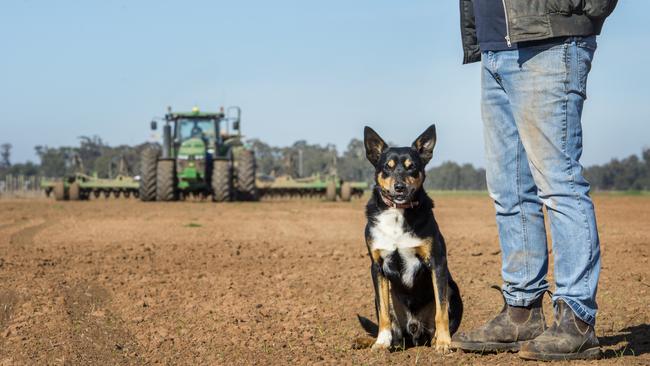Barley growers scramble to find markets as China wields tariffs
Australian barley growers are bracing for a financial hit of at least $500m a year as they scramble to find alternative markets.

Australia’s biggest barley exporter CBH Group is in talks with Japan and Vietnam to divert high quality malt barley initially destined for China and mitigate the $500m wipeout growers face from China’s decision to impose a punitive 80 per cent tariff on the grain.
Barley growers were expecting a bumper 12 million tonne crop this year after significant rainfall broke three years of drought. But now 60 to 70 per cent of that barley is looking for another market, after the People’s Republic of China imposed the high tariffs, which will cruel its trade with Australian barley growers.
While grain exporters say diverting that much grain will be a challenge, CBH chief marketing and trading officer Jason Craig said the Perth headquartered co-operative had long-term relationships with Japan, which is Australia’s second biggest buyer of barley, and Vietnam.
“CBH will continue to develop and strengthen relationships with alternative markets to ensure maximum value is returned to Western Australian barley growers,” Mr Craig said.
“CBH is active in long term markets like Japan and Vietnam for high quality malt barley and is developing relationships in new markets like India.
“In the feed market, CBH continues to work with key customers in Japan, Saudi Arabia and Thailand, as well as explore new opportunities in Indonesia after the implementation of the Indonesia-Australia Comprehensive Economic Partnership (or free trade) Agreement.”
Mr Craig said he was disappointed in the Chinese government’s decision, which was the culmination of an 18-month anti-dumping investigation, and it would not only hurt farmers but Chinese customers as well.
“As Australia’s largest barley exporter, we are deeply disappointed that the long, valued and mutually beneficial relationship with our Chinese barley customers will be compromised as a result of these hefty tariffs.
“Western Australia produces the majority of Australia’s export barley, and the introduction of these tariffs will have major implications on our growers and the Western Australian barley industry.
“This has already become evident, with significant price drops in both malt and feed barley markets following this month’s announcement that these tariffs would likely be implemented.”
The Australian understands trade talks between Australia and Japan happened on Monday, before the Chinese government’s decision, and barley was on the agenda.
Grain Growers chairman Brett Hosking was confident barley initially destined for China would find new markets, it just depended on the price point.
“There are a lot of other markets around the world and we also know that China will have to fill the void of barley from somewhere. It could well be from countries including France, Canada and even the Black Sea (area) and we know wherever their barley was destined to go those markets will now open,” Mr Hosking told The Australian.
“So I think we are going to see a change in dynamic with the way barley flows around the globe.”
But Mr Hosking said regional grain communities would be hit hard, describing China’s decision as a “kick in the guts” after emerging from three years of drought and estimated the tariffs will cost the Australian economy at least half a billion dollars.
“That’s based on what we estimate to be a little over a 12 million tonne crop and with the price penalty that could go up to $40 a tonne, that half a billion of dollars is quite achievable, particularly if you factor in flow on effects to other cereal grains, wheat sorghum.
“This is going to be a huge blow for the Australian economy right at a time when it needs every bit of help it can get, so it’s really unfortunate from that point of view.
“We probably need every Australian to go out and have a couple of beers tonight to be honest and help us consume a bit of barley.”
China announced at 11pm on Monday it would impose an anti-dumping tariff of 73.6 per cent and an additional subsidy margin of 6.9 per cent margin on Australian barley, following an 18 month investigation.
A dumping tariff is a penalty for selling barley too cheaply, while the subsidy tariff is believed to relate to Australia’s drought support measures and diesel fuel tax rebate.
It came as Prime Minister Scott Morrison spearheaded a push to investigate the origins of coronavirus at the World Health Assembly, gaining the support of more than 110 countries.
Mr Hosking said China’s claims about Australia selling barley too cheaply were unsubstantiated, with no evidence.
“We have never been the cheapest grain in the world. We produce a quality product and get paid for a quality product. We want that to continue.
“We can take a low quality home and ship it in at the cheapest price but that’s not the way we operate in Australia. The reality is we have seen no evidence in any of the submissions (to the Chinese investigation).
“We are the least subsidised country in the world. Australian farmers do not receive countervailing subsidies as claimed. Consequently, we are deeply disappointed that China has chosen to apply tariffs against the Australian barley industry.”
West Australian agriculture minister Alannah MacTiernian said the barley farmers had been caught up in “a much larger issue”.
WA is the state hardest hit by China’s decision to impose a tariff on Australia malting barley, with almost 90 per cent of the barley exported to China grown in the state.
Ms MacTiernan said tensions between Australia and China over the proposed inquiry into the origins of coronavirus had influenced the outcome.
”While we have every confidence that Australian barley is neither being dumped nor subsidised, this final outcome is not surprising, given the Chinese Ministry of Commerce’s conditional ruling less than two weeks ago,” she said.
“It would appear Western Australian barley growers have been caught up in a much larger issue.”
The 80 per cent tariff is expected to all but end the shipment of Australian malting barley to China. Farmers are expected to instead sell the product as lower-value feed for cattle and plant other crops instead.
“This decision could see a direct loss of up to $200 million to Western Australian farm incomes this year from reduced barley values and reduced wheat prices, as more farmers turn to wheat crops,” Ms MacTiernan said.
“This could have a multiplier effect in the regional economies of WA’s grainbelt.”







To join the conversation, please log in. Don't have an account? Register
Join the conversation, you are commenting as Logout